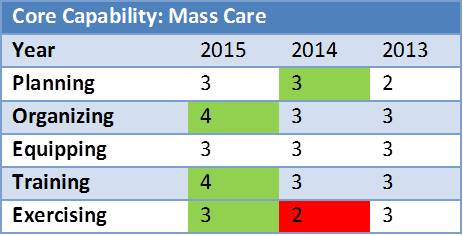Earlier in the year I posted a video (something I need to get back into doing) on the positioning of care facilities within the ICS structure (Operations, not Logistics). I’m currently reviewing some standard operating guidelines created by a county government on the management of such a facility and have made some critical observations….
The biggest observation is that the management of the facility does not have to mirror the ICS organization. What I mean here is that it really shouldn’t have its own Operations Section, Logistics Section, Planning Section, Finance/Admin Section, PIO, Safety Office, and Liaison Officer. While I commend the folks who developed this SOG for trying to stick with ICS, I think they are trying too hard. While the application of this type of organization CAN assist with management of a facility, it’s typically too much. Yes, ICS is flexible and allows us to activate only the elements needed, but often people feel compelled to utilize the organization to its fullest extent – which in this case can mean the creation of positions which are not needed. The application of ICS elements to the management of a facility can also be redundant and confusing. Besides, most jurisdictions don’t have access to multiple Planning Section Chiefs (or persons qualified in other positions) to staff all these areas.
Let’s start at the top… Facilities, per ICS definition, are overseen by Managers. Not directors or other such titles. Most facilities have very specific functional activities which should drive their organization. Yes, most of these would be considered ‘Operations’, and the support of these can be considered ‘Logistics’. But we really need to look at the responsibilities of the facility and the relationship to the rest of the incident organization to help guide us in the development of how we organize our facility management. Managers, in ICS, can have assistants, which may be all that’s needed to help address management-level issues that people may be associating with ICS positions.
Does a facility need a Public Information Office (PIO)? Probably not. ICS guidelines prescribe one PIO per incident to help ensure coordination and integrity of public information. If the facility has a need to communicate information to the pubic, they should be working through THE incident PIO. If the scope of the facilities operations are complicated enough, perhaps that function may have a designated assistant PIO to ensure proper handling of the information, but they are not the incident PIO.
Certainly facilities can have safety issues. Does they mean they should have a Safety Officer? Again, ICS prescribes that we have one incident Safety Officer. Typically the facility manager (or perhaps an assistant facility manager) will have safety included as an additional duty, in coordination with the incident Safety Officer to ensure adherence to all applicable safety standards. As with the PIO matter, if the facility for some reason has some serious safety concerns, it may warrant the placement of an assistant safety officer by the incident Safety Officer.
The function of a Liaison Officer is fairly high level, with the primary intent of supporting the Incident Commander with the coordination of various organizations involved in the response. Of course many facilities are likely to be supported by several organizations, but the participation of these organizations has already been addressed by Command, likely with the assistance of the Liaison Officer. An added Liaison Officer is simply redundant and confusing.
Logistics – while there are certainly support matters that need to be tended to in facilities – such as security, parking, sanitation, etc., this doesn’t warrant a position in the capacity of a Logistics Section Chief. Yes, they do require some oversight which may be beyond the span of control of the Facility Manager to provide. This is a good opportunity to assign a Support Services Leader or some other similarly titled position who reports to the Facility Manager. Additionally, most facilities should not be the ordering point for resources. If they need resources, the request should be sent up to the incident Logistics Section. Similarly, there is no need for a facility to have its own Finance/Admin section.
Having an incident action plan is always a critical element of organization. A care facility should certainly be included in the Incident Action Plan; reflected in objectives and organization, and tasked in a form ICS 204. That said, I certainly acknowledge that some facilities can be rather complex, with a multitude of personnel and activities and thus can benefit from having more than just an ICS 204 to run by. Select elements of an IAP can be very helpful, but a full blown IAP is generally not needed. The development of such a document for a facility generally won’t require a full time position, much less an actual Planning Section Chief. This is another opportunity to use an assistant facility manager. The check in function should be coordinated with the incident Planning Section who will either assign someone or the task will be addressed internally by the Facility Manager.
As with most things, there are always exceptions to the rule. Very large facilities with extensive operations can certainly benefit from having an overhead team. I’ve seen ‘short teams’ (these are compact versions of Incident Management Teams) assigned to manage everything from staging areas to family assistance centers in very large (Type 1) incidents. As such this is not something I would generally plan for since it would be an exception to the rule. Organizationally, a short team/overhead team would become a layer between the facility manager and the task leads/unit leaders to better allow them to focus on their functional jobs while the overhead team addressed the broader management and coordination matters. If introduced to the organization of the facility, the overhead team must have a carefully defined scope of operations to ensure they were not redundant to functions of the incident’s actual management team. Also, an overhead team such as this would likely not have a PIO or Liaison Officer.
While we try to introduce ‘hard and fast’ rules to incident management, the reality is that these things are quite fluid and determined by need. While our general preparedness should support a credible worst-case scenario, we also need to be careful with our planning assumptions. Otherwise a full-blown plan for a small community could call for a need for a dozen Liaison Officers, which we aren’t likely to get under most any circumstance. Yes, ICS is flexible, but we need to have a realistic approach. Similarly, we can use that flexibility of ICS to introduce elements into our organization that might not have been addressed in the plan with a fair amount of ease. We’re looking at the difference between a shelter in an average high school vs a shelter in a large sports stadium. All that said, if your catastrophic plan identifies the use of the large sports stadium as a shelter, you should certainly include the provision in that plan for an overhead team to assist in the management of that shelter.
Of course I’m interested in your thoughts on this.
© 2015 – Timothy Riecker
Emergency Preparedness Solutions, LLC


